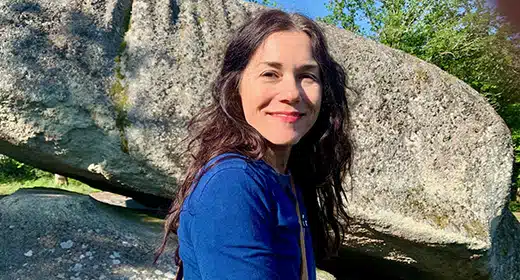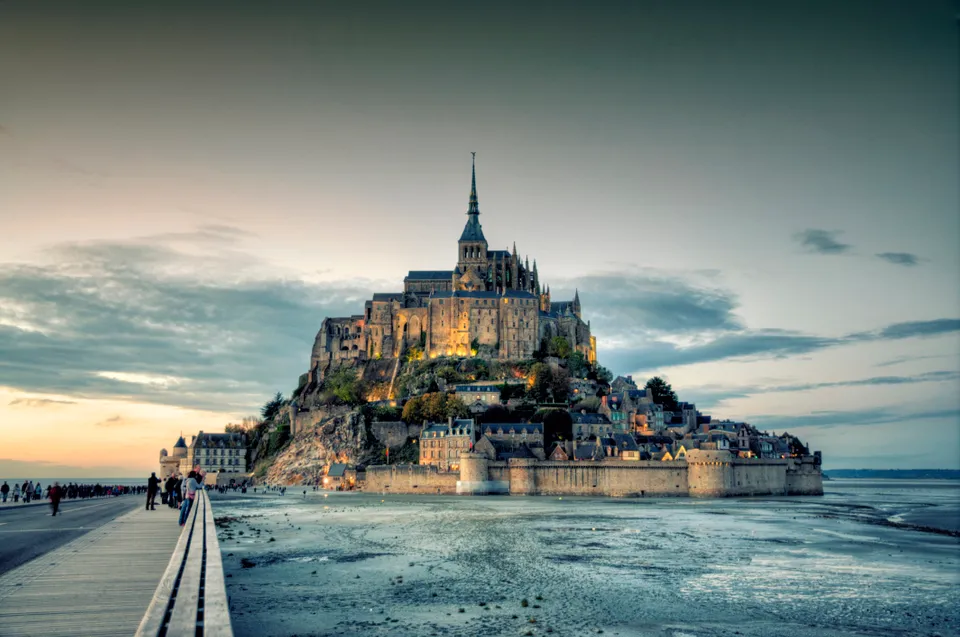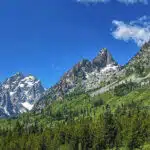From Asia to the Americas, here are some of the top religious and spiritual sites in the world…

What makes a place sacred?
Émile Durkheim, one of the founders of modern sociology, believed it was society. The collective conscience of a community comes together to touch certain mountains, trees, buildings and other ordinary objects and infuse them with a divine power, setting them apart for holy purposes.
Our world is filled with natural wonders, churches, synagogues, mosques, pilgrimage sites and other places where people have experienced the power of God and of community.
Here are 50 awe-inspiring sacred sites that you must experience in your lifetime.
*Visit sites marked with an asterisk with extra caution and reverence — our research indicates that there may be tension between indigenous people and national governments about who should have access to these sacred spots.
-
1 Vortexes, Sedona, Arizona
 Tom Bean via Getty ImagesSedona’s landscape is striking in and of itself, but practitioners of New Age spirituality believe the region is also filled with “vortex” energy sites which people can tap into for inner healing.
Tom Bean via Getty ImagesSedona’s landscape is striking in and of itself, but practitioners of New Age spirituality believe the region is also filled with “vortex” energy sites which people can tap into for inner healing. -
2 Devils Tower, Wyoming*
 Richard Cummins via Getty ImagesAlso known as “Bear Lodge,” this natural rock tower has been a site of worship and healing for over 20 Native American tribes.
Richard Cummins via Getty ImagesAlso known as “Bear Lodge,” this natural rock tower has been a site of worship and healing for over 20 Native American tribes. -
3 Washington National Cathedral, Washington, DC
 The Washington Post via Getty ImagesAlthough the Washington National Cathedral is part of the Episcopal Church, it has become a spiritual center that is open to Americans of many faiths — hosting Jewish, Muslim and Christian prayers.
The Washington Post via Getty ImagesAlthough the Washington National Cathedral is part of the Episcopal Church, it has become a spiritual center that is open to Americans of many faiths — hosting Jewish, Muslim and Christian prayers. -
4 Temple Square, Utah
 Dennis Flaherty via Getty ImagesThe Salt Lake Temple is a the largest temple associated with The Church of Jesus Christ of Latter-day Saints. While access inside of the structure is restricted to Mormons, visitors can tour the gardens of Temple Square to learn about the church’s history.
Dennis Flaherty via Getty ImagesThe Salt Lake Temple is a the largest temple associated with The Church of Jesus Christ of Latter-day Saints. While access inside of the structure is restricted to Mormons, visitors can tour the gardens of Temple Square to learn about the church’s history. -
5 Majorville Medicine Wheel, Alberta, Canada
 Forgotten Alberta Archive/FlickrMedicine wheels are stone circles or “sacred hoops” constructed long ago by Native Americans in Canada and some parts of the United States. While their original purpose is hard to pin down, some archaeologists believe the stones are aligned with the movements of the heavens and were used for healing. This 5,000-year-old medicine wheel in Majorville is believed to be the largest remaining example of this kind of sacred space.
Forgotten Alberta Archive/FlickrMedicine wheels are stone circles or “sacred hoops” constructed long ago by Native Americans in Canada and some parts of the United States. While their original purpose is hard to pin down, some archaeologists believe the stones are aligned with the movements of the heavens and were used for healing. This 5,000-year-old medicine wheel in Majorville is believed to be the largest remaining example of this kind of sacred space. -
6 Chichén Itzá, MexicoJoseIgnacioSoto via Getty Images
-
7 Our Lady of Guadalupe Shrine, Mexico
 Niciak via Getty ImagesThis basilica houses a relic important to many Catholics — the tilma (or cloak) that the Virgin Mary is said to have given the peasant Juan Diego in 1531. The cloak still bears an image of the Virgin. The basilica is now one of the most popular pilgrimage sites in the world.
Niciak via Getty ImagesThis basilica houses a relic important to many Catholics — the tilma (or cloak) that the Virgin Mary is said to have given the peasant Juan Diego in 1531. The cloak still bears an image of the Virgin. The basilica is now one of the most popular pilgrimage sites in the world. -
8 Saut-d’Eau, Haiti
 Miami Herald via Getty ImagesIn Haiti, the Voudou spirit Erzulie is closely associated with the Virgin Mary. Every summer, thousands of Haitians travel to the Saut-d’Eau waterfalls, the supposed site of a Marian apparition, to ask for favors and healing.
Miami Herald via Getty ImagesIn Haiti, the Voudou spirit Erzulie is closely associated with the Virgin Mary. Every summer, thousands of Haitians travel to the Saut-d’Eau waterfalls, the supposed site of a Marian apparition, to ask for favors and healing. -
9 Lake Atitlan, Guatemala
 Matthew Stallone via Getty ImagesAround 250 A.D., the rising waters of this lake submerged a bustling Mayan city.Archaeological evidence shows that the underwater buildings are still filled with religious paraphernalia, which means the site may have been an ancient pilgrimage destination.
Matthew Stallone via Getty ImagesAround 250 A.D., the rising waters of this lake submerged a bustling Mayan city.Archaeological evidence shows that the underwater buildings are still filled with religious paraphernalia, which means the site may have been an ancient pilgrimage destination. -
10 Salt Cathedral of Zipaquirá, Colombia
 Wolfgang Kaehler via Getty ImagesThis Catholic cathedral is located inside a salt mine, 500 feet below the ground. The space is richly decorated with sculptures cut from marble and salt.
Wolfgang Kaehler via Getty ImagesThis Catholic cathedral is located inside a salt mine, 500 feet below the ground. The space is richly decorated with sculptures cut from marble and salt. -
11 Christ the Redeemer Statue, Brazil
 Timur Emek via Getty ImagesThis 98-foot-high statue of Jesus towers over the city of Rio de Janeiro. The Art Deco sculpture is made out of concrete and its surface is covered with small triangular soapstone tiles.
Timur Emek via Getty ImagesThis 98-foot-high statue of Jesus towers over the city of Rio de Janeiro. The Art Deco sculpture is made out of concrete and its surface is covered with small triangular soapstone tiles. -
12 Machu Picchu, Peru
 DEA / N. CIRANI via Getty ImagesMachu Picchu was built by the ancient Incans during the 15th century. It served as a royal estate for nobility and houses a number of religious structures, including a “Temple of the Sun” that aligns directly with the sun’s rays during the June solstice.
DEA / N. CIRANI via Getty ImagesMachu Picchu was built by the ancient Incans during the 15th century. It served as a royal estate for nobility and houses a number of religious structures, including a “Temple of the Sun” that aligns directly with the sun’s rays during the June solstice. -
13 Easter Island Stone Giants, Chile
 Walter Bibikow via Getty ImagesThese 13-foot high statues, called moai, are carved out of volcanic ash. Many archaeologists believe the moai were created by inhabitants of Easter Island between 1400 and 1600 AD to commemorate the spirits of ancestors, tribal chiefs or other powerful male figures.
Walter Bibikow via Getty ImagesThese 13-foot high statues, called moai, are carved out of volcanic ash. Many archaeologists believe the moai were created by inhabitants of Easter Island between 1400 and 1600 AD to commemorate the spirits of ancestors, tribal chiefs or other powerful male figures. -
14 Santiago de Compostela Cathedral, Spain
 WIN-Initiative via Getty ImagesThis Spanish cathedral is the final stop on the Camino del Santiago (the Way of St. James), a network of pilgrimage routes that Christians have traveled for at leasteleven centuries. The cathedral was built to honor the tomb of St. James. Pilgrimages to the cathedral have increased in popularity in recent years, attracting visitors of all faiths.
WIN-Initiative via Getty ImagesThis Spanish cathedral is the final stop on the Camino del Santiago (the Way of St. James), a network of pilgrimage routes that Christians have traveled for at leasteleven centuries. The cathedral was built to honor the tomb of St. James. Pilgrimages to the cathedral have increased in popularity in recent years, attracting visitors of all faiths. -
15 Sagrada Familia Cathedral, Spainnarvikk via Getty Images
-
16 Stonehenge, England
 Peter Adams via Getty ImagesStonehenge was built between 3000 and 1520 B.C. While the giant outer ring is constructed from sandstone taken from local quarries, the inner ring of stones comes from about 150 miles away, in South Wales.
Peter Adams via Getty ImagesStonehenge was built between 3000 and 1520 B.C. While the giant outer ring is constructed from sandstone taken from local quarries, the inner ring of stones comes from about 150 miles away, in South Wales. -
17 Grotto of Massabielle, Lourdes, FranceJohn Elk III via Getty ImagesAccording to Catholic tradition, the Virgin Mary appeared 18 times to a young peasant girl in the grotto of Massabielle near Lourdes, France in 1858. Soon after, Catholics from around began making pilgrimages to Lourdes, hoping for healing and miracles after bathing in the grotto’s waters.
-
18 Abbey of Le Mont Saint Michel, FranceVentura Carmona via Getty ImagesMont-Saint-Michel is a Benedictine abbey that was built between the 11th and 16th centuries. The abbey is surrounded by a bay, which during particularly high tides, cuts the abbey off from the mainland completely.
-
19 Saint Michel D’Aiguilhe, France
 Andia via Getty ImagesThis chapel is built at the top of a volcanic core in the center of the French village of Le Puy-en-Velay. It is dedicated to the Archangel Michael, whom some Catholics believe has a tendency to appear to people on mountain tops.
Andia via Getty ImagesThis chapel is built at the top of a volcanic core in the center of the French village of Le Puy-en-Velay. It is dedicated to the Archangel Michael, whom some Catholics believe has a tendency to appear to people on mountain tops. -
20 St. Peter’s Basilica, Vatican City State
 Hiroshi Higuchi via Getty ImagesSt. Peter’s Basilica is a major pilgrimage site for the Roman Catholic Church. It covers the shrine of St. Peter the Apostle. Millions are expected to flock to the basilica in 2016 as part of Pope Francis’ Holy Year of Mercy, which invites Catholic priests and laypeople to rediscover their faith and practice mercy.
Hiroshi Higuchi via Getty ImagesSt. Peter’s Basilica is a major pilgrimage site for the Roman Catholic Church. It covers the shrine of St. Peter the Apostle. Millions are expected to flock to the basilica in 2016 as part of Pope Francis’ Holy Year of Mercy, which invites Catholic priests and laypeople to rediscover their faith and practice mercy. -
21 Meteora, Greece
 Jean-Pierre Lescourret via Getty ImagesMonks started finding spiritual refuge in these “columns of the sky” in the 11th century. There are 24 monasteries in the region, some with beautiful 16th century frescoes.
Jean-Pierre Lescourret via Getty ImagesMonks started finding spiritual refuge in these “columns of the sky” in the 11th century. There are 24 monasteries in the region, some with beautiful 16th century frescoes. -
22 The Temple of Apollo at Delphi, Greece
 Kelly Cheng Travel Photography via Getty ImagesThe ancient Greeks believed Delphi was the center of the world. One of the most important buildings in the complex is the Temple of Apollo, where people from all over Greece came to consult the Oracle of Delphi about the future.
Kelly Cheng Travel Photography via Getty ImagesThe ancient Greeks believed Delphi was the center of the world. One of the most important buildings in the complex is the Temple of Apollo, where people from all over Greece came to consult the Oracle of Delphi about the future. -
23 The Great Synagogue, Hungary
 Walter Bibikow via Getty ImagesThis synagogue is the “largest Jewish house of worship in the world outside New York City.” Built in 1859, the design of this structure draws is influenced by Moorish architecture. The synagogue now houses a Holocaust museum.
Walter Bibikow via Getty ImagesThis synagogue is the “largest Jewish house of worship in the world outside New York City.” Built in 1859, the design of this structure draws is influenced by Moorish architecture. The synagogue now houses a Holocaust museum. -
24 Spanish Synagogue, Czech Republic
 Izzet Keribar via Getty ImagesThis synagogue in Prague was built in 1868, over the site of a 12-century Jewish worship site. It is called “Spanish” because of its Moorish design.
Izzet Keribar via Getty ImagesThis synagogue in Prague was built in 1868, over the site of a 12-century Jewish worship site. It is called “Spanish” because of its Moorish design. -
25 Hagia Sophia, Turkey
 Ken Welsh via Getty ImagesAlso called the “Church of the Holy Wisdom,” this cathedral was built over an earlier pagan temple in the sixth century. It was repurposed as a mosque in the 1400s and is now a museum.
Ken Welsh via Getty ImagesAlso called the “Church of the Holy Wisdom,” this cathedral was built over an earlier pagan temple in the sixth century. It was repurposed as a mosque in the 1400s and is now a museum. -
26 Sultanahmet Mosque (Blue Mosque), TurkeySilvia Otte via Getty ImagesThis stunning mosque was built by the Ottoman sultan Ahmed I in the early 17th century. Its exterior features six delicate minarets (or towers), while the interior is lined with blue İznik tiles, which give the mosque its name.
-
27 Saint Basil’s Cathedral, Moscow, Russia
 Nutthavood via Getty ImagesSaint Basil’s Cathedral in Moscow, Russia is a kaleidoscope of colors and patterns. Ivan the Terrible commissioned the iconic church after defeating the Tartars of Kazan on the Feast of Intercession in 1552. The cathedral, comprised of nine primary chapels, has become a symbol of Russian culture.
Nutthavood via Getty ImagesSaint Basil’s Cathedral in Moscow, Russia is a kaleidoscope of colors and patterns. Ivan the Terrible commissioned the iconic church after defeating the Tartars of Kazan on the Feast of Intercession in 1552. The cathedral, comprised of nine primary chapels, has become a symbol of Russian culture. -
28 Stone Circles of Senegambia, Gambia and SenegalDavid Tipling via Getty ImagesThe Stone Circles of Senegambia encompass four sites of ancient monuments along the River Gambia in Gambia and Senegal. There are a total of 93 circles and 1,102 carved stones, which archaeological excavations have revealed to contain human burials and artifacts dating between the 1st and 2nd millennia to our era, according to UNESCO.
-
29 Victoria Falls, Zambia and Zimbabwe
 Paul Souders via Getty ImagesThe majestic Victoria Falls stretches along the border between Zambia and Zimbabwe. The Christian missionary and explorer David Livingstone is often credited with “discovering” the falls, but the site has been a well-known sacred destination for the region’s tribes for centuries. Locals call it “Mosi-o-Tunya,” or “the smoke that thunders.”
Paul Souders via Getty ImagesThe majestic Victoria Falls stretches along the border between Zambia and Zimbabwe. The Christian missionary and explorer David Livingstone is often credited with “discovering” the falls, but the site has been a well-known sacred destination for the region’s tribes for centuries. Locals call it “Mosi-o-Tunya,” or “the smoke that thunders.” -
30 Table Mountain, South Africa
 fivepointsix via Getty ImagesSouth Africa’s Khoi and San people believed this flat mountain top was home to their god.
fivepointsix via Getty ImagesSouth Africa’s Khoi and San people believed this flat mountain top was home to their god. -
31 Sacred Mijikenda Kaya Forests, Kenya
 Victor O’/FlickrThese forests contain the remains of ancient villages (or kayas) which were abandoned in the 1940s. The forests are now the focal point of the Mijikenda people’s religious beliefs. The kayas are still seen as the eternal homes of their ancestors.
Victor O’/FlickrThese forests contain the remains of ancient villages (or kayas) which were abandoned in the 1940s. The forests are now the focal point of the Mijikenda people’s religious beliefs. The kayas are still seen as the eternal homes of their ancestors. -
32 Bete Giyorgis, Ethiopia
 © Santiago Urquijo via Getty ImagesBete Giyorgis (Saint George) church is carved out of one single piece of stone. It is one of 11 solid rock churches in the town of Lalibela, which has become a pilgrimage site for Ethiopian Christians.
© Santiago Urquijo via Getty ImagesBete Giyorgis (Saint George) church is carved out of one single piece of stone. It is one of 11 solid rock churches in the town of Lalibela, which has become a pilgrimage site for Ethiopian Christians. -
33 Moulay Idriss, MoroccoMadrugadaVerde via Getty ImagesMoulay Idriss is considered to be the holiest city in Morocco. It is the site where the prophet Muhammad’s great-grandson, who brought Islam to Morocco 1,200 years ago, is buried.
-
34 Mt. Sinai, Egypt
 robertharding via Getty ImagesMt. Sinai is considered to be the site where God revealed the Ten Commandments to Moses. The sacred mountain is important for Jews, Christians and Muslims.
robertharding via Getty ImagesMt. Sinai is considered to be the site where God revealed the Ten Commandments to Moses. The sacred mountain is important for Jews, Christians and Muslims. -
35 Jerusalem
 Cosmo Condina via Getty ImagesJerusalem is a city of ancient religious significance, considered holy in Christianity, Judaism and Islam alike. Located in the Judean Mountains between the Mediterranean Sea and the Dead Sea, the city is believed to be the site of Solomon’s Temple and the Second Temple, Jesus’s Last Supper and Muhammad’s Night of Ascension.
Cosmo Condina via Getty ImagesJerusalem is a city of ancient religious significance, considered holy in Christianity, Judaism and Islam alike. Located in the Judean Mountains between the Mediterranean Sea and the Dead Sea, the city is believed to be the site of Solomon’s Temple and the Second Temple, Jesus’s Last Supper and Muhammad’s Night of Ascension. -
36 Safed, Israel
 Yadid Levy / robertharding via Getty ImagesSafed is perched at the highest point of Israel and is considered one of the country’s four holy cities. In the 1600s it became the center of Kabbalah, or Jewish mysticism, where mystics lived, studied and shared ideas.
Yadid Levy / robertharding via Getty ImagesSafed is perched at the highest point of Israel and is considered one of the country’s four holy cities. In the 1600s it became the center of Kabbalah, or Jewish mysticism, where mystics lived, studied and shared ideas. -
37 Lotus Temple, India
 Renaud Visage via Getty ImagesThe Lotus Temple is a Bahāʾī house of worship, or a mashriq, that is shaped like a floating lotus flower. Bahāʾīs consider the lotus to be a symbol of “purity, beauty, and divinity.”
Renaud Visage via Getty ImagesThe Lotus Temple is a Bahāʾī house of worship, or a mashriq, that is shaped like a floating lotus flower. Bahāʾīs consider the lotus to be a symbol of “purity, beauty, and divinity.” -
38 Golden Temple, Amritsar, India
 Westend61 via Getty ImagesThe Golden Temple, located in Amritsar, India, is historically a central religious site for the Sikh faith. The temple averages fifty thousand visitors daily and is open to anyone who comes seeking spiritual comfort and solace.
Westend61 via Getty ImagesThe Golden Temple, located in Amritsar, India, is historically a central religious site for the Sikh faith. The temple averages fifty thousand visitors daily and is open to anyone who comes seeking spiritual comfort and solace. -
39 Kumbh Mela, India
 Subir Basak via Getty ImagesThe Kumbh Mela is a mass pilgrimage in India that brings thousands of Hindus together to bathe in one of four sacred rivers. The pilgrimage derives its name from a mythical fight in Hindu tradition that took place between gods and demons over a pitcher of holy nectar. It is believed that four drops of the nectar spilled, landing in the four cities that take turns hosts the festival. In 2016 the Kumbh Mela will take place in Haridwar and Ujjain.
Subir Basak via Getty ImagesThe Kumbh Mela is a mass pilgrimage in India that brings thousands of Hindus together to bathe in one of four sacred rivers. The pilgrimage derives its name from a mythical fight in Hindu tradition that took place between gods and demons over a pitcher of holy nectar. It is believed that four drops of the nectar spilled, landing in the four cities that take turns hosts the festival. In 2016 the Kumbh Mela will take place in Haridwar and Ujjain. -
40 Shwedagon Pagoda, MyanmarThis 2,500-year-old sacred site is composed of hundreds of temples, stupas and statues. Devotees, monks, and tourists visit the complex to see a shrine manybelieve holds strands of Buddha’s hair.
-
41 Bodhi Tree, Bodh Gaya, India
 Lissillour via Getty ImagesThe famous Bodhi Tree in Bodh Gaya, India is believed to be the site at which Siddhartha Gautama, later known as Buddha, attained enlightenment. Bodhi is a Sanskrit word that translates to “awakening.”
Lissillour via Getty ImagesThe famous Bodhi Tree in Bodh Gaya, India is believed to be the site at which Siddhartha Gautama, later known as Buddha, attained enlightenment. Bodhi is a Sanskrit word that translates to “awakening.” -
42 Angkor Wat, Cambodia
 altrendo travel via Getty ImagesThis massive archaeological site in Siem Reap is over 400 square miles and contains numerous temples, canals, and monuments. It was the capital of the Khmer Empire from the 9th to 15th centuries.
altrendo travel via Getty ImagesThis massive archaeological site in Siem Reap is over 400 square miles and contains numerous temples, canals, and monuments. It was the capital of the Khmer Empire from the 9th to 15th centuries. -
43 Shikoku, Japan
 Doug McKinlay via Getty ImagesShikoku is a Japanese island and the birthplace of Kobo-Daishi, a revered monk and teacher who helped popularize Buddhism in Japan in the 9th century. The 750-mile pilgrimage route connects 88 temples and shrines, and each portion is said to represent a step toward nirvana.
Doug McKinlay via Getty ImagesShikoku is a Japanese island and the birthplace of Kobo-Daishi, a revered monk and teacher who helped popularize Buddhism in Japan in the 9th century. The 750-mile pilgrimage route connects 88 temples and shrines, and each portion is said to represent a step toward nirvana. -
44 Mt. Kailash, Tibet
 Hiroyuki Nagaoka via Getty ImagesBoth Buddhists and Hindus consider Mt. Kailash to be a spiritual home for the gods. According to tradition, a pilgrimage to Mt. Kailash can help erase bad karma accumulated over a lifetime.
Hiroyuki Nagaoka via Getty ImagesBoth Buddhists and Hindus consider Mt. Kailash to be a spiritual home for the gods. According to tradition, a pilgrimage to Mt. Kailash can help erase bad karma accumulated over a lifetime. -
45 Potala Palace, Lhasa, Tibet Autonomous Region
 Photograph by Shuo Yang via Getty ImagesPotala Palace has served as the winter palace of the Dalai Lama since the 7th century, and it is where the current Dalai Lama was installed in 1940. It is now a World Heritage Site, housing thousands of Buddhist artifacts.
Photograph by Shuo Yang via Getty ImagesPotala Palace has served as the winter palace of the Dalai Lama since the 7th century, and it is where the current Dalai Lama was installed in 1940. It is now a World Heritage Site, housing thousands of Buddhist artifacts. -
46 Temple and Cemetery of Confucius, Shandong Province, China
 William Perry via Getty ImagesThe Temple and Cemetery of Confucius is located in China’s Shandong Province beside what was once the philosopher’s sprawling family mansion. The cemetery contains Confucius’ tomb, as well as more than 100,000 graves of his descendants.
William Perry via Getty ImagesThe Temple and Cemetery of Confucius is located in China’s Shandong Province beside what was once the philosopher’s sprawling family mansion. The cemetery contains Confucius’ tomb, as well as more than 100,000 graves of his descendants. -
47 Temple of Heaven, Beijing, China
 Allan Montaine via Getty ImagesThe Temple of Heaven, located in Beijing, China, is said to symbolize the relationship between earth and heaven. Founded in the early 15th century, the temple originally served as a site for cultural rites performed by the ruling emperor.
Allan Montaine via Getty ImagesThe Temple of Heaven, located in Beijing, China, is said to symbolize the relationship between earth and heaven. Founded in the early 15th century, the temple originally served as a site for cultural rites performed by the ruling emperor. -
48 Meiji Shrine, Japan
 Bloomberg via Getty ImagesThis is Tokyo’s most famous Shinto shrine and is dedicated to the souls of Japan’s Emperor Meiji and Empress Shoken.
Bloomberg via Getty ImagesThis is Tokyo’s most famous Shinto shrine and is dedicated to the souls of Japan’s Emperor Meiji and Empress Shoken. -
49 Uluru, Ayers Rock, Australia*
 Michael Dunning via Getty ImagesThe indigenous Anangu people believe that this sandstone monolith was created by their ancestors during Dreamtime, a time beyond memory.
Michael Dunning via Getty ImagesThe indigenous Anangu people believe that this sandstone monolith was created by their ancestors during Dreamtime, a time beyond memory. -
50 Baiame Cave, Australia
 kateausburn/FlickrLocated in the Australian state of New South Wales, Baiame Cave is site of significance named after the figure in Aboriginal culture believed to be the creator of the universe. The cave contains a large painting of Baiame, making it a rare example of indigenous rock art in the region.
kateausburn/FlickrLocated in the Australian state of New South Wales, Baiame Cave is site of significance named after the figure in Aboriginal culture believed to be the creator of the universe. The cave contains a large painting of Baiame, making it a rare example of indigenous rock art in the region.































































